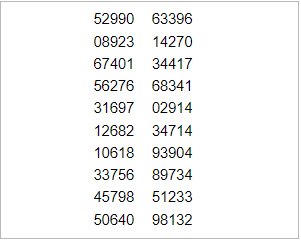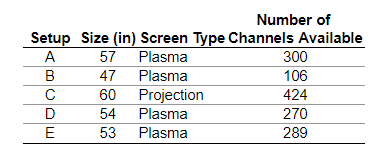Navigation » List of Schools, Subjects, and Courses » Math 227 – Statistics » Quizzes » Chapter 1 Quiz
With Answers Good news! We are showing you only an excerpt of our suggested answer to this question. Should you need our help in customizing an answer to this question, feel free to send us an email at  or chat with our customer service representative.
or chat with our customer service representative.
Chapter 1 Quiz
Chapter 1 Quiz
1. Determine the level of measurement of the variable below. Dress color. Choose the correct answer below.
- Nominal
- Ratio
- Ordinal
- Interval
2. A polling organization contacts 2558 female university graduates who have a white collar job and asks whether or not they had received a raise at work during the past 6 months. What is the population in the study?
- Female university graduates who have received a raise at work.
- Female university graduates.
- Female university graduates who have a white collar job and have received a raise at work.
- Female university graduates who have a white collar job.
What is the sample in the study?
- Female university graduates.
- The 2558 female university graduates who have a white collar job.
- Female university graduates who have a white collar job.
- The 2558 female university graduates who have received a raise at
3. Suppose you are the president of the student government. You wish to conduct a survey to determine the student body’s opinion regarding student services. The administration provides you with a list of the names and phone numbers of the 437 registered students.
(a) Discuss a procedure you could follow to obtain a simple random sample of 5 students.
(b) Obtain this sample.

(a) Which of the following procedures could you follow to obtain a simple random sample of 5 students? Select all that apply.
- List the names in alphabetical order and take the first five names on the list.
- List each name on a separate piece of paper; place them all in a hat, and pick five.
- Ask the students to come to a meeting and pick five from those who come to the meeting.
- Number the names from 1 to 437 and use a random number table to produce 5 different three-digit numbers corresponding to the names selected.
(b) Obtain this sample using the portion of the random number table provided in the problem statement. Start with the first column of the first row and work down each column.
Type the numbers corresponding to the students chosen. ______________ (Use a comma to separate answers as needed.)
4. Determine whether the quantitative variable is discrete or continuous.Goals scored by a forward in a hockey game. Is the variable discrete or continuous?
- The variable is discrete because it is not countable.
- The variable is continuous because it is not countable.
- The variable is discrete because it is countable.
- The variable is continuous because it is countable.
5. Define statistics.Choose the correct answer below.
- Statistics encompasses all scientific disciplines in which random occurrences are analyzed. In addition, statistics references any random occurrence which is reported using percentages or proportions.
- Statistics encompasses all scientific disciplines in which percentages are used, data are analyzed, and probabilities are found. In addition, statistics references any mathematical model which is reported using percentages or proportions.
- Statistics is the science of collecting, organizing, summarizing, and analyzing information to draw a conclusion and answer questions. In addition, statistics is about providing a measure of confidence in any conclusions.
- Statistics is the science of manipulating, reorganizing, and editing information to produce the desired results. In addition, statistics is about providing the required answer with the desired level of confidence.
6. A(n) __________ is obtained by dividing the population into homogeneous groups and randomly selecting individuals from each group.
7. Determine whether the study depicts an observational study or an experiment. Fifty patients with liver disease are divided into two groups. One group is treated with an experimental drug. The other is not. After two months, both groups are questioned about their energy level.
Is the study an observational study or an experiment?
- The study is an observational study because the study examines individuals in a sample, but does not try to influence the response variable.
- The study is an experiment because the study examines individuals in a sample, but does not try to influence the variable of interest.
- The study is an experiment because the researchers control one variable to determine the effect on the response variable.
- The study is an observational study because the researchers control one variable to determine the effect on the response variable.
8. The data on the right relate to characteristics of high-definition televisions A through E. Identify the individuals, variables, and data corresponding to the variables. Determine whether each variable is qualitative, continuous, or discrete.

What are the individuals being studied?
- Plasma and projection widescreen high-definition televisions.
- Televisions with screen sizes between 40 in and 60 in.
- The high-definition television setups A through E.
- Television setups that include more than 100 channels.
What are the variables and their corresponding data being studied?
- Size (57, 47, 60, 54, 53) and number of channels available (300, 106, 424, 270, 289)
- Setup (A, B, C, D, E), size (57, 47, 60, 54, 53), screen type (Plasma, Plasma, Projection, Plasma, Plasma), and number of channels available (300, 106, 424, 270, 289)
- Size (57, 47, 60, 54, 53), screen type (Plasma, Plasma, Projection, Plasma, Plasma), and number of channels available (300, 106, 424, 270, 289)
Determine whether each variable is qualitative, continuous, or discrete.
Size is a ______ variable.
Screen type is a ______ variable.
Number of channels available is a ______variable.
9. The survey has bias. (a) Determine the type of bias. (b) Suggest a remedy. A polling organization conducts a study to estimate the percentage of households that have their children in private schools. It mails a questionnaire to 1112 randomly selected households across the country and asks the head of each household if he or she has their children in private schools. Of the 1112 households selected, 30 responded.
(a) Which of these best describes the bias in the survey?
- Undercoverage bias
- Nonresponse bias
- Response bias
- Sampling bias
(b) How can the bias be remedied?
- The polling organization should try contacting households that do not respond by phone or face-to-face.
- The polling organization should mail the questionnaire to a greater number of households.
- The polling organization should only select households in a single state.
- The polling organization should mail the questionnaire to each person in the households.

